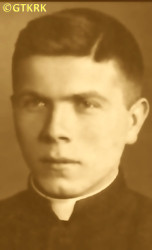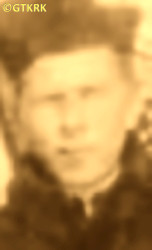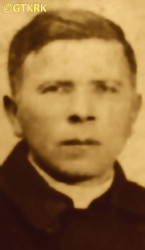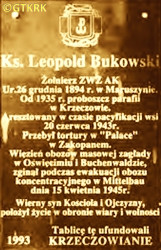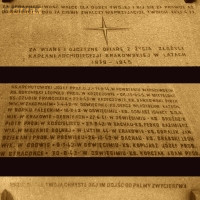Roman Catholic
St Sigismund parish
05-507 Słomczyn
85 Wiślana Str.
Konstancin deanery
Warsaw archdiocese, Poland
full list:
displayClick to display full list

searchClick to search full list by categories
wyświetlKliknij by wyświetlić pełną listę po polsku

szukajKliknij by przeszukać listę wg kategorii po polsku

Martyrology of the clergy — Poland
XX century (1914 – 1989)
personal data
surname
BUKOWSKI
forename(s)
Leopold
function
diocesan priest
creed
Latin (Roman Catholic) Church RCmore on
en.wikipedia.org
[access: 2014.09.21]
diocese / province
Cracow archdiocesemore on
en.wikipedia.org
[access: 2013.05.19]
RC Military Ordinariate of Polandmore on
en.wikipedia.org
[access: 2014.12.20]
honorary titles
„Cross of Independence”more on
en.wikipedia.org
[access: 2019.02.02]
(09.10.1933)
date and place
of death
15.04.1945

KL Sachsenhausenconcentration camp
today: Sachsenhausen‐Oranienburg, Oberhavel dist., Brandenburg state, Germany
more on
en.wikipedia.org
[access: 2018.11.18]
alt. dates and places
of death
KL Buchenwaldconcentration camp
today: n. Weimar, Weimar urban dist., Thuringia state, Germany
more on
en.wikipedia.org
[access: 2022.01.09]
KL Mittelbau‐Doraconcentration camp
today: n. Nordhausen, Nordhausen dist., Thuringia state, Germany
more on
en.wikipedia.org
[access: 2022.01.09]
details of death
During World War I soldier No. 3159 — from 1914 — of the 12th Company, 3rd Infantry Regiment of the Polish Legions, as part of the Austro–Hungarian Imperial Army.
Participant in the Carpathian Campaign.
On 15.02.1915 wounded in the Battle of Markova near Nadvirna. In 05.1915 treated in a hospital in Nowy Targ.
After returning to the unit, fought on the Volyn Front. During the largest Russian offensive on the Eastern Front against the Central Powers (Germany and Austria–Hungary), known as the Brusilov Offensive, that begun on 04.06.1916, taken prisoner by the Russians near Vovchytsk in Volyn. It happened on 05.07.1916, i.e. on the first day of the Battle of Kostyukhnivka, during which the Polish Legions were forced to withdraw, but prevented the front from being broken through, which turned out to be a de facto strategic triumph for the Central Powers.
Released in 03.1918, after separatist Brześć Treaty on 03.03.1918 between Germany/Austro–Hungary and Russia.
In 1920 took part with other seminarians from Theological Seminary in Kraków in Polish–Russians war of 1919‐1921.
After German and Russian invasion of Poland in 09.1939 and start of the World War II, after start of German occupation, colaborated with the Polish clandestine resistance movement Armed Struggle Union ZWZ — later Home Army AK — and Polish partisan units (part of Polish Clandestine State).
Arrested by the Germans — agents of SiPo und SD security services — on 20.06.1943 during the pacification of Krzeczów (organized by the Germans under the code name «Grossaktion Dora») together with his vicar, Fr Francis Czubin, among others (Fr Czubin was executed on the spot).
Accused of hiding church bells Germans ordered to be handed in and melted for weaponry production.
Beaten and taken to Zakopane Palace prison and from there to Montelupich Str. prison in Kraków.
On 20.07.1943 transported to KL Auschwitz concentration camp.
From there on c. 24.06.1944 transferred to KL Buchenwald concentration camp.
On 28.10.1944 registered in KL Mittelbau‐Dora concentration camp.
Prob. perished during evacuation of KL Mittelbau‐Dora concentration camp — at the beginning of 04.1945 forced by Germans onto cattle track trains and forwarded towards KL Sachsenhausen concentration camp.
Perished on the way and was registered as a victim of KL Sachsenhausen camp.
alt. details of death
Perished as a victim of one of two concentration camps — KL Buchenwald or KL Mittelbau‐Dora (both liberated by American troops on 11.04.1945).
Prob. at the beginning of 04.1945 forced in KL Mittelbau‐Dora by Germans onto cattle track trains and forwarded towards other concentration camps: KL Bergen‐Belsen, KL Sachsenhausen, KL Ravensbrück or KL Neuengamme.
On the way perished.
Could also had been forced to march on foot from KL Mittelbau‐Dora and perish in Gardelegen, for instance, where Germans burnt on 13.04.1945 c. 1,016 prisoners, mainly Poles, in a barn.
prisoner camp's numbers
62540Click to display source page (KL BuchenwaldClick to display the description), 130365Click to display source page (KL AuschwitzClick to display the description)
cause of death
extermination
perpetrators
Germans
sites and events
KL SachsenhausenClick to display the description, KL Mittelbau‐DoraClick to display the description, KL BuchenwaldClick to display the description, KL AuschwitzClick to display the description, Regierungsbezirk KattowitzClick to display the description, Cracow (Montelupich)Click to display the description, Zakopane (Palace)Click to display the description, «Grossaktion Dora» in KrzeczówClick to display the description, GeneralgouvernementClick to display the description, Ribbentrop‐MolotovClick to display the description, Pius XI's encyclicalsClick to display the description, Polish‐Russian war of 1919‐1921Click to display the description
date and place
of birth
26.12.1894

Maruszynatoday: Szaflary gm., Nowy Targ pov., Lesser Poland voiv., Poland
more on
en.wikipedia.org
[access: 2021.12.18]
parents
BUKOWSKI James
🞲 ?, ? — 🕆 ?, ?

STRAMA Anne
🞲 ?, ? — 🕆 ?, ?
baptism
27.12,1894

Szaflarytoday: Szaflary gm., Nowy Targ pov., Lesser Poland voiv., Poland
more on
en.wikipedia.org
[access: 2025.03.27]
St Andrew the Apostle RC church
presbyter (holy orders)
ordination
29.06.1922

Lvivtoday: Lviv urban hrom., Lviv rai., Lviv obl., Ukraine
more on
en.wikipedia.org
[access: 2022.01.16]
positions held
1935 – 1943
curatus/rector/expositus — Krzeczówtoday: Lubień gm., Myślenice pov., Lesser Poland voiv., Poland
more on
en.wikipedia.org
[access: 2022.01.28] ⋄ St Adalbert the Bishop and Martyr RC church ⋄ Lubieńtoday: Lubień gm., Myślenice pov., Lesser Poland voiv., Poland
more on
en.wikipedia.org
[access: 2021.12.18]
en.wikipedia.org
[access: 2020.07.31], St John the Baptist RC parish ⋄ Mszana Dolnatoday: Mszana Dolna gm., Limanowa pov., Lesser Poland voiv., Poland
more on
en.wikipedia.org
[access: 2020.07.31] RC deanery
1928 – 1935
vicar — Więcławicetoday: Więcławice Stare, Michałowice gm., Kraków pov., Lesser Poland voiv., Poland
more on
pl.wikipedia.org
[access: 2021.12.19] ⋄ St James the Apostle RC parish ⋄ Mogiłatoday: part of Kraków, Kraków city pov., Lesser Poland voiv., Poland
more on
pl.wikipedia.org
[access: 2020.07.31] RC deanery
1928
vicar — Bodzanówtoday: Biskupice gm., Wieliczka pov., Lesser Poland voiv., Poland
more on
en.wikipedia.org
[access: 2021.12.18] ⋄ St Peter and St Paul the Apostles RC parish ⋄ Niepołomicetoday: Niepołomice gm., Wieliczka pov., Lesser Poland voiv., Poland
more on
en.wikipedia.org
[access: 2021.06.07] RC deanery
1927 – 1928
vicar — Niepołomicetoday: Niepołomice gm., Wieliczka pov., Lesser Poland voiv., Poland
more on
en.wikipedia.org
[access: 2021.06.07] ⋄ Ten Thousands of Saint Martyrs RC parish ⋄ Niepołomicetoday: Niepołomice gm., Wieliczka pov., Lesser Poland voiv., Poland
more on
en.wikipedia.org
[access: 2021.06.07] RC deanery
1927
vicar — Jaworznotoday: Jaworzno city pov., Silesia voiv., Poland
more on
en.wikipedia.org
[access: 2021.04.01] ⋄ St Adalbert the Bishop and Martyr and St Catherine Virgin and Martyr RC parish ⋄ Nowa Góratoday: Krzeszowice gm., Kraków pov., Lesser Poland voiv., Poland
more on
en.wikipedia.org
[access: 2021.06.07] RC deanery
1922 – 1926
vicar — Osiektoday: Osiek gm., Oświęcim pov., Lesser Poland voiv., Poland
more on
en.wikipedia.org
[access: 2021.12.18] ⋄ St Andrew the Apostle RC parish ⋄ Oświęcimtoday: Oświęcim gm., Oświęcim pov., Lesser Poland voiv., Poland
more on
en.wikipedia.org
[access: 2021.06.07] RC deanery
1918 – 1922
student — Krakówtoday: Kraków city pov., Lesser Poland voiv., Poland
more on
en.wikipedia.org
[access: 2021.06.07] ⋄ philosophy and theology, Theological Seminary ⋄ Kraków RC archdiocese
others related
in death
DAŃKOWSKIClick to display biography Peter Edward, CZUBINClick to display biography Francis, DOMERACKIClick to display biography Joseph Valentine, DROŹDZIKClick to display biography Peter, DRWALClick to display biography Francis, DRWĘSKIClick to display biography Stanislav Felix (Bro. Felician), GLAKOWSKIClick to display biography Stanislav, HANKEClick to display biography Francis, HAROŃSKIClick to display biography Leo Joseph, HUWERClick to display biography Joseph, KULISZClick to display biography Charles, KUPILASClick to display biography Francis, LANGNERClick to display biography Herbert, PANKOWSKIClick to display biography Marian, POLEDNIAClick to display biography Paul, PRZYWARAClick to display biography Peter, ROGACZEWSKIClick to display biography Adalbert Theophilus, ROZMUSClick to display biography Vincent, SCHULZClick to display biography Joseph Valentine, SEKRECKIClick to display biography Henry, SOSINClick to display biography Joseph, STASZEWSKAClick to display biography Helen (Sr Mary Clementa), STOCKClick to display biography Joseph, SZEMBEKClick to display biography Francis Vladimir, SZOTTClick to display biography Francis Michael, WĄDRZYKClick to display biography Anthony
sites and events
descriptions
KL Sachsenhausen: In Germ. Konzentrationslager (Eng. concentration camp) KL Sachsenhausen, set up in the former Olympic village in 07.1936, hundreds of Polish priests were held in 1940, before being transported to KL Dachau. Some of them perished in KL Sachsenhausen. Murderous medical experiments on prisoners were carried out in the camp. In 1942‐1944 c. 140 prisoners slaved at manufacturing false British pounds, passports, visas, stamps and other documents. Other prisoners also had to do slave work, for Heinkel aircraft manufacturer, AEG and Siemens among others. On average c. 50,000 prisoners were held at any time. Altogether more than 200,000 inmates were in jailed in KL Sachsenhausen and its branched, out of which tens of thousands perished. Prior to Russian arrival mass evacuation was ordered by the Germans and c. 80,000 prisoners were marched west in so‐called „death marches” to other camps, i.e. KL Mauthausen‐Gusen and KL Bergen‐Belsen. The camp got liberated on 22.04.1945. After end of armed hostilities Germans set up there secret camp for German prisoners and „suspicious” Russian soldiers. (more on: en.wikipedia.orgClick to attempt to display webpage
[access: 2018.11.18])
KL Mittelbau‐Dora: German Germ. Konzentrationslager (Eng. concentration camp) KL, operational from 08.1943 till 11.04.1945 when American troops entered the camp. Set up to provide the slave workforce for an underground military factory „Mittelwerk” — in tunnels of Kohnstein mountain n. Nordhausen town V‐1 and V‐2 rockets were manufactured. Initially functioned as a sub‐camp of KL Buchenwald concentration camp (till summer 1944). Approx. 20,000 prisoner perished (large part of them were brought there at the end of 1944, in „death marches”, from KL Auschwitz), among whom 10,000 during camp evacuation (which also took form of „death marches”) — in 04.1945, right before liberation. Also c. 1,200 prisoners perished during bombardments by the Allied forces. (more on: en.wikipedia.orgClick to attempt to display webpage
[access: 2022.01.09])
KL Buchenwald: In German Germ. Konzentrationslager (Eng. concentration camp) KL Buchenwald concentration camp, founded in 1937 and operational till 1945, Germans held c. 238,380 prisoners and murdered approx. 56,000 of them, among them thousands of Poles. Prisoners were victims of pseudo‐scientific experiments, conducted among others by Behring‐Werke from Marburg and Robert Koch Institute from Berlin companies. They slaved for Gustloff in Weimar and Fritz‐Sauckel companies manufacturing armaments. To support Erla‐Maschinenwerk GmbH in Leipzig, Junkers in Schönebeck (airplanes) and Rautal in Wernigerode Germans organized special sub‐camps. In 1945 there were more than 100 such sub‐camps. Dora concentration camp was initially one of them, as well as KL Ravensbrück sub‐camps (from 08.1944). On 08.04.1945 Polish prisoner, Mr Guido Damazyn, used clandestinely constructed short wave transmitter to sent, together with a Russian prisoner, a short message begging for help. It was received and he got a reply: „KZ Bu. Hold out. Rushing to your aid. Staff of Third Army” (American). Three days later the camp was liberated. (more on: www.buchenwald.deClick to attempt to display webpage
[access: 2013.08.10], en.wikipedia.orgClick to attempt to display webpage
[access: 2013.08.10])
KL Auschwitz: German Germ. Konzentrationslager (Eng. concentration camp) KL and Germ. Vernichtungslager (Eng. extermination camp) VL Auschwitz was set up by Germans around 27.01.1940 n. Oświęcim, on the German territory (initially in Germ. Provinz Schlesien — Silesia Province; and from 1941 Germ. Provinz Oberschlesien — Upper Silesia Province). Initially mainly Poles were interned. From 1942 it became the centre for holocaust of European Jews. Part of the KL Auschwitz concentration camps’ complex was Germ. Vernichtungslager (Eng. extermination camp) VL Auschwitz II Birkenau, located not far away from the main camp. There Germans murdered likely in excess of million people, mainly Jews, in gas chambers. In KL Auschwitz alone, the Germans murdered c. 30,000 prisoners by lethal injection. Until 1941, people were killed by intravenous injections of concentrated hydrogen peroxide, ether, hydrogen peroxide, or gasoline. Later, an intracardiac injection was used — with a needle about 10 cm long — of 10‐15 ml of a 30% solution of phenol C6H5OH (acquired from the German concern IG Farben, or more precisely from its subsidiary Bayer, and still used by Bayer AG, among others, for the production of aspirin), which killed within 15 seconds. Altogether In excess of 400 priests and religious went through the KL Auschwitz, c. 40% of which were murdered (mainly Poles). (more on: en.auschwitz.org.plClick to attempt to display webpage
[access: 2012.11.23], www.meczennicy.pelplin.plClick to attempt to display webpage
[access: 2013.07.06])
Regierungsbezirk Kattowitz: After the Polish defeat in the 09.1939 campaign, which was the result of the Ribbentrop‐Molotov Pact and constituted the first stage of World War II, and the beginning of German occupation in part of Poland (in the other, eastern part of Poland, the Russian occupation began), the Germans divided the occupied Polish territory into five main regions (and a few smaller). The largest one was transformed into Germ. Generalgouvernement (Eng. General Governorate), intended exclusively for Poles and Jews and constituting part of the so‐called Germ. Großdeutschland (Eng. Greater Germany). From two separate new provinces were created. The two remaining were incorporated into existing German provinces. One of those was Polish Upper Silesia, which on 08.09.1939, by decree of the German leader Adolf Hitler (formally came into force on 26.10.1939), was incorporated into Germany as the Germ. Regierungsbezirk Kattowitz (Eng. Katowice Regency) and became part of the Germ. Provinz Schlesien (Eng. Province of Silesia) based in Wrocław. On 01.04.1940, the Germ. Regierungsbezirk Kattowitz was enlarged by several pre‐war German counties, and on 18.01.1941, a new German province was created, the Germ. Provinz Oberschlesien (Eng. Province of Upper Silesia), which, apart from the Germ. Regierungsbezirk Kattowitz, also included the Opole region. From 26.10.1939, when the regency was established, the law of the German state was in force there, the same as in Berlin. The main axis of the policy of the new regency, the territory of which the Germans recognized as the Germ. „Ursprünglich Deutsche” (Eng. „natively German”), despite the fact only 6% of its pre–war Polish part were Germans, was Germ. „Entpolonisierung” (Eng. „Depolonisation”), i.e. forced Germanization. The main mechanism was the introduction of the Germ. Deutsche Volksliste DVL, a German nationality list that was supposed to specify the national affiliation of the inhabitants of the region. The largest group marked in the compulsory registrations was Group 3, people who identified themselves as „Silesians” (in 1943 about 41%), and people remaining outside the DVL (about 36%). The latter group was intended to be deported to the Germ. Generalgouvernement (which did not happen en masse because German industry needed slave labor). Group 3, considered by the Germans as capable of Germanization, was subject to certain legal restrictions, and was subject to, among others, to conscription into the German Wehrmacht army. Children could only learn in German. A policy of terror was pursued against the Polish population. There was a special police court, controlled by the Germ. Geheime Staatspolizei (Eng. Secret State Police), i.e. the Gestapo, before which c. 4,000‐5,000 people were detained. For the years 1942‐1945 over 2,000 of them were verified, of which 1,890 were sentenced to death, including 286 in public executions. Thousands of people were murdered during the so‐called «Intelligenzaktion Schlesien», including 300‐650 Polish teachers and c. 61 Polish Catholic priests. The regency hosted a German concentration and extermination camp KL Auschwitz, where the Germans imprisoned c. 1,100,000 Jews (murdering c.1,000,000, i.e. c. 90% of them) and c. 140,000 Poles (murdering c. 70,000, i.e. c. 50% of them). After the end of hostilities of World War II, the overseer of this province, the Germ. Reichsstatthalter (Eng. Reich Governor) and the Germ. Gauleiter (Eng. district head) of the German National Socialist Party, Fritz Brecht, committed suicide. (more on: en.wikipedia.orgClick to attempt to display webpage
[access: 2024.06.24])
Cracow (Montelupich): Cracow penal prison, during occupation run by the Germans — from 28.02.1941 by Germ. Geheime Staatspolizei (Eng. Secret State Police, known as Gestapo. In 1940‐1944 Germans jailed there approx. 50,000 prisoners, mainly Poles and Jews. Some of them were transported to KL Auschwitz concentration camp, some were executed. After cease in war effort the prison was used by UB — a Polish unit of Russian NKVD — as a prison for Polish independence resistance fighters, some of which were subsequently sent to prisons and slave labour camps in Russia. (more on: en.wikipedia.orgClick to attempt to display webpage
[access: 2014.10.31])
Zakopane (Palace): Penal institution and investigative prison set up by German Germ. Geheime Staatspolizei (Eng. Secret State Police), i.e. Gestapo, in „Palace” guesthouse in renown spa Zakopane at the foot of Tatra mountains. Functioned from the start of German occupation in 10.1939 to 01.1945. Place of mass executions and cruel tortures — the victims were beaten, tormented, hanged — of scores of Poles. It is estimated that c. 2,000 inmates were held captive in „Palace” prison 400 of which were murdered by the Germans — some in the prison itself, others at the local Sucha Dolina (Eng. Dry Valley) cemetery. Most of the others were sent to German concentration camps, mainly KL Auschwitz, were the majority perished. (more on: z-ne.plClick to attempt to display webpage
[access: 2021.12.19])
«Grossaktion Dora» in Krzeczów: 20.06.1943 the Germans — led by Germ. Inspektor Sicherheitspolizei und SD (Eng. head of the security service) from Zakopane, de facto head of the border police station and Germ. Geheime Staatspolizei (Eng. Secret Political Police), i.e. Gestapo, in Zakopane — carried out, under the codename «Grossaktion Dora», the pacification of the village of Krzeczów. The Polish resistance of the Union of Armed Struggle ZWZ, transformed in 1942 into the Home Army AK, together with partisan units (part of the Polish Underground State), part of the Kraków ZWZ‐AK Inspectorate structures, operated in the village. Initially, mainly information activities, distribution of underground press, were carried being out, but over time military training was implemented. Weapons were secured for the needs of the planned uprising. In 1942, the ZWZ‐AK had 9 sworn men, with 8 rifles and several hundred rounds of ammunition. In 1943, the Germans found out about the group — mainly due to the conspirators' carelessness. On the night of 19—20.06.1943 surrounded the village. During the pacification Germans murdered 10 people in clashes, 9 (including one Catholic priest) were executed in the local cemetery after interrogation and bloody torture. 3 were murdered in the nearby village of Tenczyn. Several people, including two priests and one nun, were taken to concentration camps. Several residential buildings were burned down. (more on: krakow.ipn.gov.plClick to attempt to display webpage
[access: 2024.09.11])
Generalgouvernement: After the Polish defeat in the 09.1939 campaign, which was the result of the Ribbentrop‐Molotov Pact and constituted the first stage of World War II, and the beginning of German occupation in part of Poland (in the other, eastern part of Poland, the Russian occupation began), the Germans divided the occupied Polish territory into five main regions. In two of them new German provinces were created, two other were incorporated into other provinces. However, the fifth part was treated separately, and in a political sense it was supposed to recreate the German idea from 1915 (during World War I, after the defeat of the Russians in the Battle of Gorlice in 05.1915) of creating a Polish enclave within Germany. Illegal in the sense of international law, i.e. Hague Convention, and public law, managed by the Germans according to separate laws — especially established for the Polish Germ. Untermenschen (Eng. subhumans) — till the Russian offensive in 1945 it constituted part of the Germ. Großdeutschland (Eng. Greater Germany). Till 31.07.1940 formally called Germ. Generalgouvernement für die besetzten polnischen Gebiete (Eng. General Government for the occupied Polish lands) — later simply Germ. Generalgouvernement (Eng. General Governorate), as in the years 1915‐1918. From 07.1941, i.e. after the German attack on 22.06.1941 against the erstwhile ally, the Russians, it also included the Galicia district, i.e. the Polish pre‐war south‐eastern voivodeships. A special criminal law was enacted and applied to Poles and Jews, allowing for the arbitrary administration of the death penalty regardless of the age of the „perpetrator”, and sanctioning the use of collective responsibility. After the end of the military conflict of the World War UU, the government of the Germ. Generalgouvernement was recognized as a criminal organization, and its leader, governor Hans Frank, guilty of war crimes and crimes against humanity and executed. (more on: en.wikipedia.orgClick to attempt to display webpage
[access: 2024.12.13])
Ribbentrop‐Molotov: Genocidal Russian‐German alliance pact between Russian leader Joseph Stalin and German leader Adolf Hitler signed on 23.08.1939 in Moscow by respective foreign ministers, Mr. Vyacheslav Molotov for Russia and Joachim von Ribbentrop for Germany. The pact sanctioned and was the direct cause of joint Russian and German invasion of Poland and the outbreak of the World War II in 09.1939. In a political sense, the pact was an attempt to restore the status quo ante before 1914, with one exception, namely the „commercial” exchange of the so‐called „Kingdom of Poland”, which in 1914 was part of the Russian Empire, fore Eastern Galicia (today's western Ukraine), in 1914 belonging to the Austro‐Hungarian Empire. Galicia, including Lviv, was to be taken over by the Russians, the „Kingdom of Poland” — under the name of the General Governorate — Germany. The resultant „war was one of the greatest calamities and dramas of humanity in history, for two atheistic and anti‐Christian ideologies — national and international socialism — rejected God and His fifth Decalogue commandment: Thou shall not kill!” (Abp Stanislav Gądecki, 01.09.2019). The decisions taken — backed up by the betrayal of the formal allies of Poland, France and Germany, which on 12.09.1939, at a joint conference in Abbeville, decided not to provide aid to attacked Poland and not to take military action against Germany (a clear breach of treaty obligations with Poland) — were on 28.09.1939 slightly altered and made more precise when a treaty on „German‐Russian boundaries and friendship” was agreed by the same murderous signatories. One of its findings was establishment of spheres of influence in Central and Eastern Europe and in consequence IV partition of Poland. In one of its secret annexes agreed, that: „the Signatories will not tolerate on its respective territories any Polish propaganda that affects the territory of the other Side. On their respective territories they will suppress all such propaganda and inform each other of the measures taken to accomplish it”. The agreements resulted in a series of meeting between two genocidal organization representing both sides — German Gestapo and Russian NKVD when coordination of efforts to exterminate Polish intelligentsia and Polish leading classes (in Germany called «Intelligenzaktion», in Russia took the form of Katyń massacres) where discussed. Resulted in deaths of hundreds of thousands of Polish intelligentsia, including thousands of priests presented here, and tens of millions of ordinary people,. The results of this Russian‐German pact lasted till 1989 and are still in evidence even today. (more on: en.wikipedia.orgClick to attempt to display webpage
[access: 2015.09.30])
Pius XI's encyclicals: Facing the creation of two totalitarian systems in Europe, which seemed to compete with each other, though there were more similarities than contradictions between them, Pope Pius XI issued in 03.1937 (within 5 days) two encyclicals. In the „Mit brennender Sorge” (Eng. „With Burning Concern”) published on 14.03.1938, condemned the national socialism prevailing in Germany. The Pope wrote: „Whoever, following the old Germanic‐pre‐Christian beliefs, puts various impersonal fate in the place of a personal God, denies the wisdom of God and Providence […], whoever exalts earthly values: race or nation, or state, or state system, representatives of state power or other fundamental values of human society, […] and makes them the highest standard of all values, including religious ones, and idolizes them, this one […] is far from true faith in God and from a worldview corresponding to such faith”. On 19.03.1937, published „Divini Redemptoris” (Eng. „Divine Redeemer”), in which criticized Russian communism, dialectical materialism and the class struggle theory. The Pope wrote: „Communism deprives man of freedom, and therefore the spiritual basis of all life norms. It deprives the human person of all his dignity and any moral support with which he could resist the onslaught of blind passions […] This is the new gospel that Bolshevik and godless communism preaches as a message of salvation and redemption of humanity”… Pius XI demanded that the established human law be subjected to the natural law of God , recommended the implementation of the ideal of a Christian state and society, and called on Catholics to resist. Two years later, National Socialist Germany and Communist Russia came together and started World War II. (more on: www.vatican.vaClick to attempt to display webpage
[access: 2023.05.28], www.vatican.vaClick to attempt to display webpage
[access: 2023.05.28])
Polish‐Russian war of 1919‐1921: War for independence of Poland and its borders. Poland regained independence in 1918 but had to fight for its borders with former imperial powers, in particular Russia. Russia planned to incite Bolshevik‐like revolutions in the Western Europe and thus invaded Poland. Russian invaders were defeated in 08.1920 in a battle called Warsaw battle („Vistula river miracle”, one of the 10 most important battles in history, according to some historians). Thanks to this victory Poland recaptured part of the lands lost during partitions of Poland in XVIII century, and Europe was saved from the genocidal Communism. (more on: en.wikipedia.orgClick to attempt to display webpage
[access: 2014.12.20])
sources
personal:
pl.auschwitz.orgClick to attempt to display webpage
[access: 2012.11.23], polacywberlinie.plClick to attempt to display webpage
[access: 2013.05.19], www.straty.plClick to attempt to display webpage
[access: 2015.04.18], wykaz.muzeumpilsudski.plClick to attempt to display webpage
[access: 2018.04.02], krakow.ipn.gov.plClick to attempt to display webpage
[access: 2024.09.11], skanoteka.genealodzy.plClick to attempt to display webpage
[access: 2025.03.27]
bibliographical:
„International Tracing Service (ITS), Bad Arolsen, GermanyClick to display source page”, Arolsen Archives
original images:
krakow.ipn.gov.plClick to attempt to display webpage
[access: 2024.09.11], krakow.ipn.gov.plClick to attempt to display webpage
[access: 2024.09.11], sercepodhala.plClick to attempt to display webpage
[access: 2025.02.18], krakow.ipn.gov.plClick to attempt to display webpage
[access: 2024.09.11]
LETTER to CUSTODIAN/ADMINISTRATOR
If you have an Email client on your communicator/computer — such as Mozilla Thunderbird, Windows Mail or Microsoft Outlook, described at WikipediaPatrz:
en.wikipedia.org, among others — try the link below, please:
LETTER to CUSTODIAN/ADMINISTRATORClick and try to call your own Email client
If however you do not run such a client or the above link is not active please send an email to the Custodian/Administrator using your account — in your customary email/correspondence engine — at the following address:

giving the following as the subject:
MARTYROLOGY: BUKOWSKI Leopold
To return to the biography press below:
 Click to return to biography
Click to return to biography








